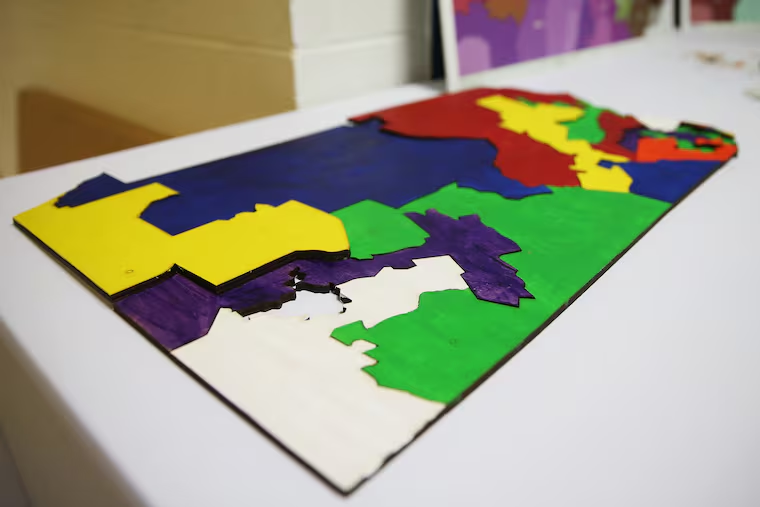Republicans ‘got greedy’ in drawing Pennsylvania congressional maps, new documents say
A trove of documents recently released by the daughter of a deceased GOP strategist includes some clues about what Republicans were thinking almost a decade ago when they redrew Pennsylvania’s congressional maps in a way that was later ruled unconstitutional.

A trove of documents recently released by the daughter of a deceased GOP strategist includes some clues about what Republicans were thinking almost a decade ago when they redrew Pennsylvania’s congressional maps in a way that was later ruled unconstitutional.
The documents, compiled at least partly amid the decennial redistricting that took place in 2011, include a warning that the party “got greedy” in an attempt to create districts favorable to GOP candidates 10 years earlier.
The disclosure came in files posted by the daughter of Thomas Hofeller. Before his death in 2018, he was a leading force behind GOP redistricting efforts across the country.
“GOP gerrymandering got greedy the last time and bad political climate caused it to unravel,” one of the state-by-state analysis documents in the files said of Pennsylvania. “Democrats will be concentrating on trying to safe up their gains.”
That was presumably a reference to the congressional maps Republicans drew in 2001, which created more districts that were only marginally GOP friendly. Some of them were captured by Democrats in the 2006 election amid unrest over the Iraq War.
Gerrymandering is the process of drawing congressional or legislative districts to favor a political party. Lines are typically drawn following the decennial census.
Hofeller’s estranged daughter, Stephanie, discovered the files following his death and started sharing them with news organizations and other groups. They figured prominently in a fight the Trump administration ultimately lost before the Supreme Court in its attempt to add a citizenship question to the 2020 Census. Stephanie Hofeller made the files public by posting them Sunday on a website she created called the Hofeller Files.
The files are voluminous and disorganized, and include many personal items, such as a recipe for coconut cake and an offer for a free consultation from Wisteria Landscapers. But among the political files were some references to Pennsylvania. It’s not clear whether those files were created by Hofeller or others.
“That document confirms what we already knew. Pennsylvania was in the cross hairs of national political operatives who sought and for a time succeeded in manipulating districts not to benefit voters in those districts, but to serve a national political agenda,” said Benjamin Geffen, an attorney who represented Democratic plaintiffs in Pennsylvania who sued over the 2011 congressional maps.
Neal Lesher, a spokesman for Republican State House Speaker Mike Turzai, declined to comment directly on the memo that referenced a “greedy” GOP gerrymander. While previous reporting has indicated Hofeller advised state Republicans on redistricting, Lesher said Hofeller was not involved.
“They seem to be notes to himself,” Lesher said. “We did not have any contact with this gentleman or use him for our [2011] maps. ... To the degree that there are notes in his papers for Pennsylvania seems to merely suggest he was taking notes.”
In 2018, the Pennsylvania Supreme Court struck down the state’s congressional maps as violating the state constitution. At the time, of the 18 members of the state’s delegation to the House of Representatives, 13 were Republicans and five were Democrats. That meant Republicans held about 72% of the House seats in the state, despite winning just 54% of total votes in Pennsylvania congressional elections in 2016.
Ultimately, the state Supreme Court drew its own maps, which were in place for the 2018 election. That made districts in the Philadelphia suburbs considerably more favorable for Democrats. Now, Republicans hold nine of 18 seats.
J.J. Balaban, a Democratic political consultant who has worked on Pennsylvania House races, laughed at the “greedy” reference to what is presumably the 2001 maps. He said the maps that came after that were arguably much more gerrymandered to favor Republicans.
The 2001 maps, Balaban said, “had some continuity of keeping communities together. ... It was considered undoable to split Erie [County] into two districts, but it happened [in 2011].”
There were other districts carved up in odd shapes. The former 7th District, which was based in Delaware County, was said to look like Goofy kicking Donald Duck and became a running joke among redistricting experts and hobbyists.
A separate state-by-state analysis file from 2011 also found in Hofeller’s files said: “The Democrats felt they were badly stung last time and will fight for better results this time. The RNC is already involved, and expects to assist in both line-drafting and litigation. Given the fact that some of our presently held seats are weak, the GOP will be hard pressed to make the Democrats ‘eat’ the one-seat loss.”
Hofeller also had a file detailing how much it would cost for each state to legally fight redistricting challenges. Pennsylvania had a $300,000 price tag. It was one of 13 states where Republicans anticipated they would need to spend money defending maps in litigation.